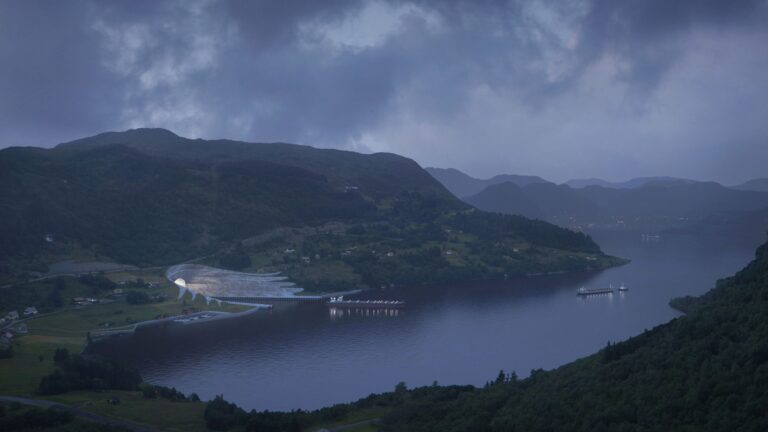In a few years, maritime traffic will be able to avoid one of the most dangerous stretches of the Norwegian coastline. Here’s the story of the remarkable Stad ship tunnel.
If you've ever sailed along the Norwegian coast, chances are you've encountered patches of rough sea. If so, one of those places was likely the Stad peninsula.

The stretch of water surrounding the peninsula is notorious as one of the most dangerous parts of the entire Norwegian coastline. In early 2019, the Viking Sky lost power and narrowly avoided disaster in the area.
I’ve also experienced the power of Stad for myself. When I was on the Hurtigruten’s MS Vesterålen in 2018, passengers were sent back to their cabins due to the severe rocking motion of the ship while passing through the area.
The problem with Stad
The ocean around the Stad peninsula is subject to challenging ocean currents. Combined with the underwater topology, this creates complex and unpredictable wave conditions.

When the winds are strong, this creates demanding conditions for even the most experienced maritime professionals. High waves can come from different directions and can last for several days after a storm, leading to potential problems even on calm days.
Introducing the Stad ship tunnel
To improve safety for vessels, a remarkable ship tunnel is in the advanced stages of planning. It has been given the green light with an expected cost of NOK 3.45 billion.
The Stad Ship Tunnel will be the world’s longest tunnel for maritime traffic. The tunnel will be 1.7 km long, 37 meters high, and 36 metres wide.
According to the Norwegian Coastal Administration, 81% of today’s ship traffic can use the tunnel. That will include the Hurtigruten and Havila coastal cruise ferries and some smaller cruise ships.
Benefits of the Stad ship tunnel
According to the project team, the tunnel “will make sea transport safer, more efficient, and more environmentally friendly.”
“The Stad ship tunnel is necessary to achieve the political goal of moving transport from road to sea and will facilitate safe and environmentally friendly sea transport in the coastal and maritime industries in the future,” continues the statement.

Industries set to benefit include fishing vessels, Bilge well vessels, service vessels, container ships, and cruise ships. For commercial shipping, the tunnel will mean safer and quicker deliveries, and better quality retention of raw materials.
That's because in bad weather, fishing vessels are unwilling to sail around Stad. This means increased wait time and reduced quality. The world’s largest fish farming company, Mowi, is among the strongest supporters of the ship tunnel.
According to simulations, fuel consumption should be reduced by between 60% (for ships around 40 meters) to 30% (ships around 140 meters) when using the tunnel route.
It’s also fair to say that the tunnel will become a tourist attraction for the region. Project leaders hope it will become a landmark for Norway’s western cape, in a similar way to the visitor centre at the North Cape. As the tunnel will be big enough for the Hurtigruten and Havila coastal ships to sail through, it’s easy to see that happening.
But the Norwegian Coastal Administration’s Einar Vik Arset said the primary goal is to improve safety. “We are working to ensure that the Norwegian coast is the safest and cleanest in the whole world. Projects such as the Stad ship tunnel are important measures to realise our goals.”
Location and size of the tunnel
The precise location of the tunnel had been subject to some debate. As you can see from the illustration below, the tunnel will take advantage of a narrow section of the Stad peninsula that’s some distance away from the open sea.

Nearby places that may receive an economic boost from the tunnel’s construction include Måløy and the small villages Selje, Åheim and Fiskåbygd.
Design of the ship tunnel
Renowned Norwegian architecture firm Snøhetta designed the tunnel entrances. They also designed walkways and the construction of a new road bridge to give visitors a view of ships entering and exiting the tunnel.
According to Snøhetta, the design focuses on “merging the surrounding natural and cultural landscape with the tunnel’s large scale.”

“The terraces are built on stone carved out of the mountain where the tunnel is created. Using wire-cutting and blasting, the terraces will have a naturally rough form within the precise geometry of the horizontal lines. In addition to creating a link to the area’s cultural landscape, the geometry is also highly beneficial for the structural stability of the portal,” said Snøhetta.
Project status and next steps
The government gave the green light for the construction of the tunnel and included startup funds in the state budget for 2021. In the recently proposed 2023 budget, funding was once again committed to the project.
The project is expected to cost NOK 3.45 billion to build. At the present time, the plan is to start the physical construction work in 2024.


Very cool idea! I hope it will be big enough for the Viking ocean cruise ships. We sailed from Bergen to the Nordkapp on the Viking Star in July 2018 and enjoyed our port call in Molde and I crossed the Atlantic Ocean Road off of my bucket list. We were fortunate to have calm seas the whole time. The Barents Sea at the Nordkapp was almost like a large lake.